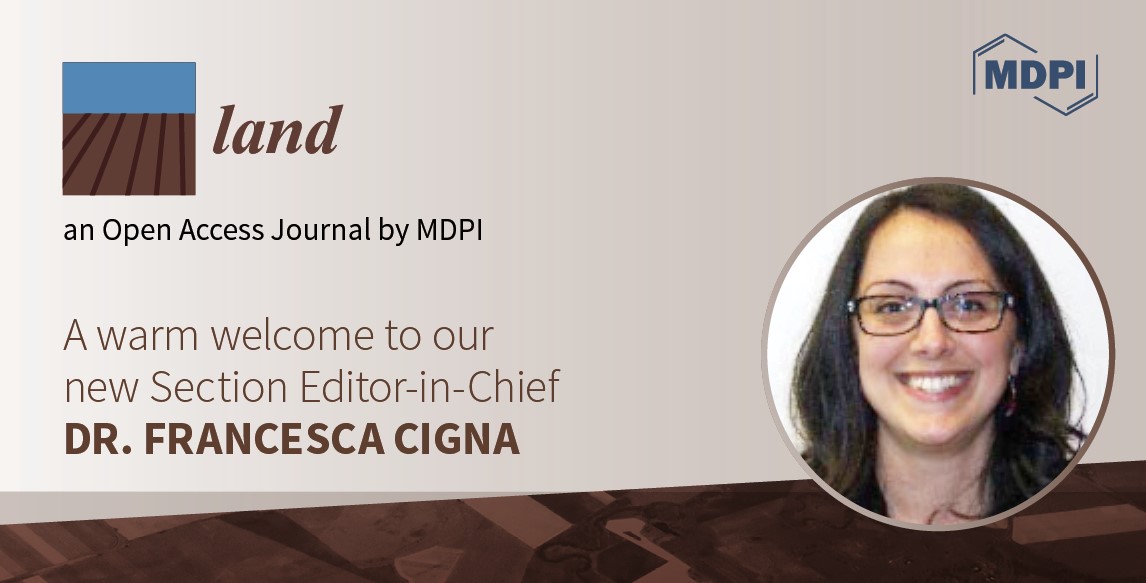
Dr. Francesca Cigna Appointed Editor-in-Chief of the New Section “Landscape Archaeology” in Land
We are pleased to announce that Dr. Francesca Cigna has been appointed Editor-in-Chief of the newly established Section “Landscape Archaeology” in Land (ISSN 2073-445X, IF 3.398).
Dr. Francesca Cigna, an environmental engineer with a Ph.D. in Earth sciences, is a senior researcher in Earth observation at the Institute of Atmospheric Sciences and Climate of the National Research Council of Italy. She has extensive experience in satellite remote sensing, GIS, radar image processing, change detection methods and big data analytics. Her main research areas of investigation are mapping and monitoring natural and anthropogenic hazards in urban and rural environments, ground instability, land changes, landscape archaeology and cultural heritage applications.
The following is a short Q&A with Dr. Francesca Cigna, who shared her vision for the Section with us, as well as her views of the research area:
1. What appealed to you about the journal that made you want to take the role as its Section Editor-in-Chief?
Since its launch in 2012, Land has rapidly demonstrated that there is an active and vibrant research community working on a broad range of topics related to land systems and landscapes, yet not so many international journals offer a valuable outlet to publishing these topics through an efficient peer-reviewing and editorial process. Reputation and impact of Land have grown over the past years, enabling a high positioning of the journal within the Environmental Science subject area. The journal therefore offers a good environment to collect high quality studies and discussions in the field, and there is no doubt that this represents a stimulating opportunity for me to contribute to the journal’s goals and objectives as the Editor-in-Chief of one of its thematic Sections.
2. Can you briefly introduce your current research work in landscape archaeology?
As an Earth observation scientist, I look at the topic from a technical perspective, trying to investigate how remote sensing data, image analysis methodologies and digital technologies can address scientific questions and research goals by providing valuable information on characteristics and evolution of past archaeological landscapes, from the regional to the more local scale. Big data, enhanced imaging resolutions, open access archives and cloud platforms are the resources that I exploit the most in this field, with a look to investigating semi-arid regions and catchments in South America and human-impacted Mediterranean landscapes and sites in the current context of urbanization and anthropogenic site disturbance.
3. What does the future of this field of research look like?
The future of this research field looks like a lot of fun! Whilst we will surely continue to use well-established on-site surveying and investigation methods, technological development will continue to enable an increasing number of new opportunities, in terms of both data acquisition instrumentation types and sensing capabilities, and novel approaches for semi-automated data classification, machine and deep learning, artificial intelligence and advanced digital technologies. Curiosity and research questions will lead the way in the upcoming years, with the community making the best out of novel data and methods to address fundamental and new questions with original, prototyping and pioneering approaches and workflows.
4. What is your vision for the Section?
In my vision, the launch of this new Section of Land, fully dedicated to landscape archaeology, is the first step towards the consolidation of this research field with a body of high-impact literature that will also contribute to an even brighter future for the journal more widely. I am keen to open the doors of the Section to highly motivated early career scientists and young researchers to contribute as authors and/or editors (e.g., through the Special Issue Mentor Program) to enable the development and embedding of novel ideas and the launch of new thematic volumes on “hot topics” and recent discoveries.
5. What do you think of the development of Open Access in the publishing field?
Nowadays, Open Access principles and practices are among the most welcomed features in scientific publishing. As an author, I have experienced a much wider dissemination and often higher impact of my open access research papers across the community, even reaching out to practitioners and specialists outside the university or major research institutions who might not have access to journal subscriptions. Further development of the principles of Open Access in this field will likely stimulate faster and more widespread scientific exchange and development.
We warmly welcome Dr. Francesca Cigna to her new role as Section Editor-in-Chief, and we look forward to her leading Land to many more milestones.